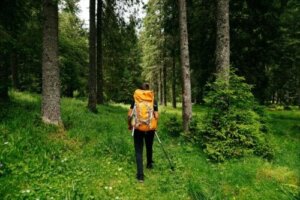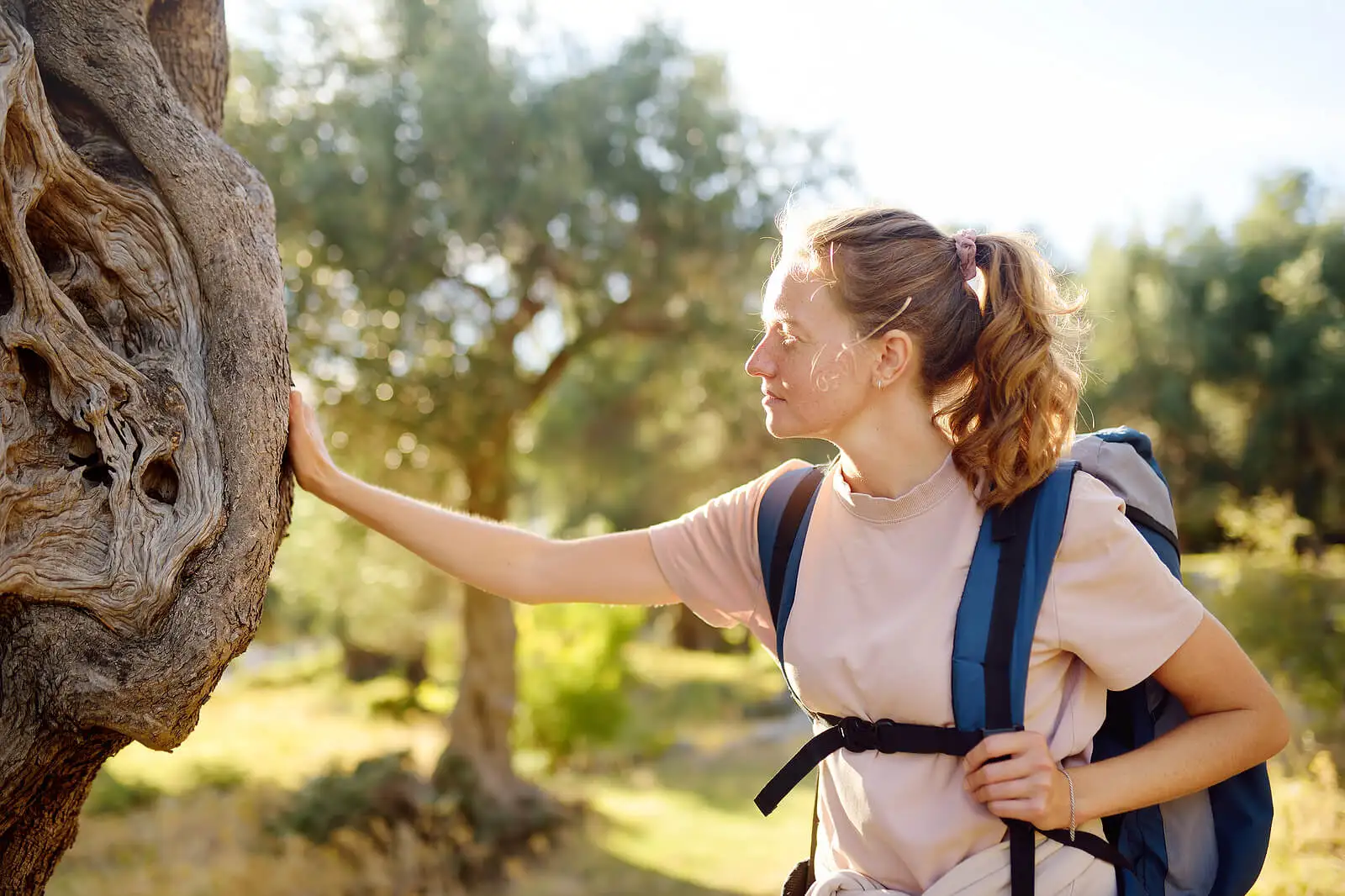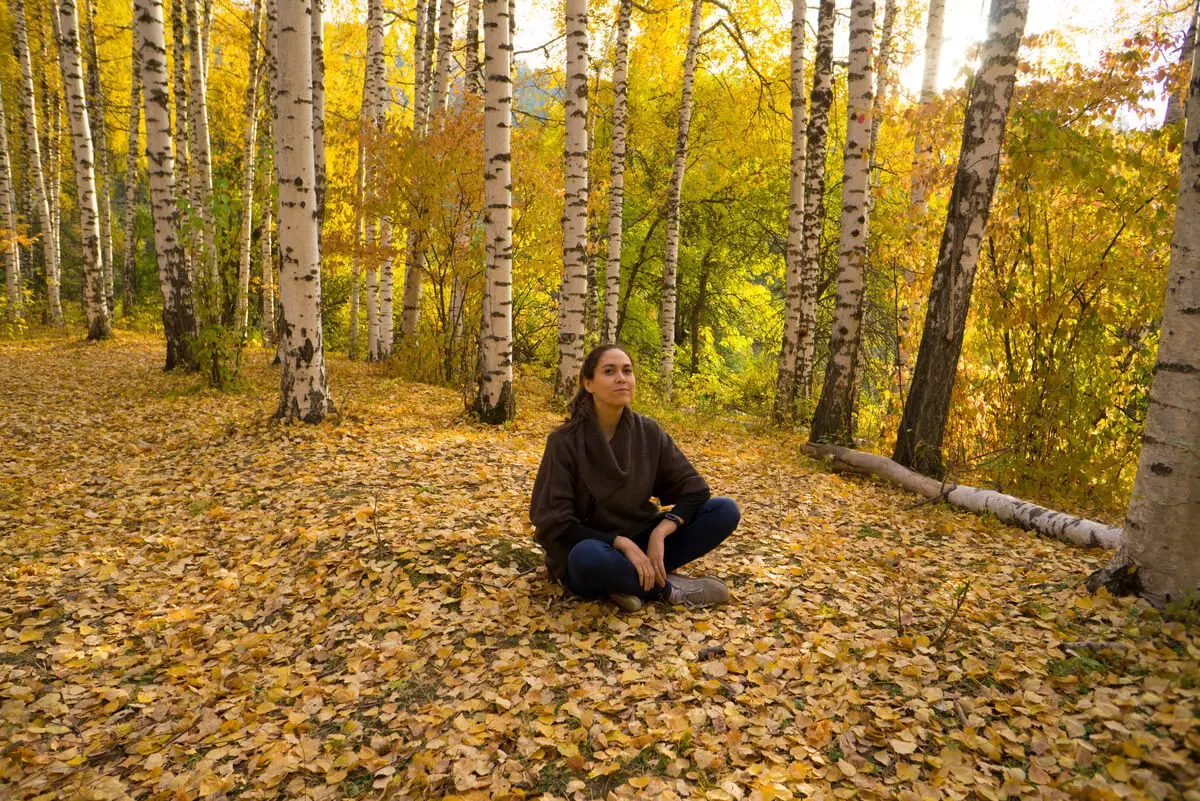Shinrin Yoku or Forest Bathing: What Are The Benefits?


Reviewed and approved by the psychologist Elena Sanz
Nature has many medicinal effects on both our physical and mental energy. One of the growingly popular forms of natural treatments is a form of reconnection called ‘Shinrin Yoku,’ a treatment that’s been known for its ability to reduce anxiety and stress. Its main objective is to promote well-being through contact with nature.
Specifically, it’s an experience that’s considered to form part of forest medicine, a discipline that proposes forests as a source of health. Strolling through the forest, enjoying the sound of the branches and leaves, contemplating the sky, and breathing fresh air have significant benefits for the body. So, what are the beneficial effects of forest bathing? Find out here!
What is “Shinrin Yoku”?
In Japanese ‘Shinrin’ means “forest,” while ‘Yoku’ means “to bathe.” The combination of the two words translates as “forest bathing” and refers to spending time in the woods in search of happiness and better health.
The therapy dates back to the 1980s when the Japanese were pursuing a healthy lifestyle by detaching themselves from the urban and detoxifying from the technological boom that became overwhelming for so many people.
A treatment with spiritual roots, “bathing” in the forest consists of enjoying nature as you walk aimlessly. The goal is to soak in the environment. In this way, this form of ecotherapy is believed to boost the immune system.
And while more research is needed, the International Journal of Mental Health and Addiction reports findings on the effectiveness of Shinrin Yoku in reducing symptoms of anxiety.

We think you may also enjoy reading this article: Micromeditation: What It Is, Its Benefits, and How to Practice It
These are the benefits of “Shinrin Yoku”
Enhancing your quality of life and preventing psychological and physical illnesses are the main benefits linked to “forest bathing.” In fact, the International Journal of Forest Medicine claims that in the future, doctors will prescribe forest bathing as a preventive treatment.
By connecting with the natural environment, the senses are alert to perceive smells, textures, images, sounds, and even tastes. You also get exercise from walking, which translates into countless extra benefits.
It improves mood
A study conducted by the International Journal of Environmental Research and Public Health found that walking in wooded areas decreases negative emotional states, specifically referring to the following:
- Anger and hostility
- Fatigue and confusion
- Tension and anxiety
- Depression and discouragement
Instead, the research revealed that forest walks increased participants’ positive moods and sense of vigor.
As an initiation to the method, walk for at least 40 minutes in a forest.
Forest bathing strengthens the immune system
The Mesoamerican Center for the Exchange of Knowledge and Forestry Experiences points out that therapies in nature increase the physiological effects of relaxation.
In addition, the essential oils released by plants and trees affect the body’s defenses and support the body’s resistance to disease. On this point, several studies speak of the preventive action of ecotherapy on immune functions. The effects are reflected in the following benefits:
- It protects the heart: the Spanish Heart Foundation emphasizes that long-term activities in nature have a good influence on cardiovascular health.
- It soothes chronic pain: The state of relaxation brought about by walks in the forest tends to alleviate aches and pains in patients with severe pain, fibromyalgia, or fatigue.
- It helps regulate blood pressure: A “forest bath” can provide a different measure of blood pressure before and after the walk. In theory, contemplating nature causes blood pressure to drop and contributes to better blood circulation.
It decreases sleep disorders
The “forest bathing” practiced during the evening is of benefit to nighttime sleep in terms of time, depth, and quality. By relaxing, people have less difficulty sleeping.
It lowers stress levels
Cortisol is the stress hormone linked to headaches, skin disorders, elevated blood pressure, and other conditions. But how does a forest bath control the secretion of this hormone?
According to the Association of Nature and Forest Therapies, the experience reduces cortisol levels by stimulating rest and preserving energy.
It enhances creativity
Immersing oneself in the forest is advantageous to the creative instinct. A National Geographic interview reviews a study that the University of Kansas conducted with a group of backpackers who traveled for three days and showed increased cognitive ability and creativity upon their return.
Also, time immersed among trees provides a break from technology and information, which opens the way to new sources of inspiration.
In this regard, the American Heart Association comments that a change of scenery is an excellent alternative to revive the creative vein, since in nature, you find stimuli that screens do not provide.
Forest bathing can help keep your lungs healthy
The book Principles of Internal Medicine explains that the respiratory system oxygenates the blood and eliminates carbon dioxide, which requires a virtual contact between fresh air and blood.
The World Health Organization highlights that 99% of the world’s population breathes air that exceeds the quality limits. Although thousands of cities monitor the air, people live with unhealthy levels of nitrogen dioxide and particulate matter.
“Forest baths” help clean the lungs from the accumulation of gases and other types of urban pollution that cause problems in their activity.
What to keep in mind for “Shinrin Yoku”
These walks require time and zero haste. You also have to pay attention to the messages that nature sends in order to strengthen the relationship. To undertake this form of exploration, you may need the following tools:
- A map with your complete route.
- Enough water to maintain hydration along the way.
- A backpack in which to carry some necessary belongings.
- Comfortable clothing, including sports shoes or hiking boots.
Like this article? You may also like to read: Slow Deco: Learn What It Is and How to Apply It To Your Home
How to forest bath
Although this type of therapy is valid alone or in a group, at least the first time, it’s a good idea to have the support of a guide certified by the associations of forest medicine. For the tour, perform the following steps:
- Select a forest: Your excursions to “bathe” in wooded areas shouldn’t be improvised. The process begins with choosing a forest – preferably without slopes – but with a variety of trails, wetlands, rocks, clearings, and species.
- Experience the sensations: Go at a gentle pace and in complete silence to let intuition lead. If you wish, hug a tree, taste an edible berry, or touch a rock. Listen to the sounds of nature and smell the environment. Allow your feet to step on the earth for a moment.
- Stop and enjoy the experience: There will be a moment to pause the journey, form a circle and share the experience. To do this, the participants may take a natural element in their hands as a sign that they will have the floor. After expressing their feelings, they pass the element to a partner.
- Tea ceremony: These sessions usually last from 40 minutes to 3 hours; when they end, the guide offers an infusion prepared with plants collected along the way. This action symbolizes the integration between the forest and the person.

Who can take a “forest bath”?
We are all candidates for “forest baths,” especially when going through episodes of stress. Likewise, those who need to exercise due to medical recommendations find these walks a fun and healthy option. If physical impediments make it difficult to go into the woods, it’s possible to practice Shinrin Yoku in virtual environments. Research has found similarities between the real forest environment and the psychological effects and environmental features of digital ecotherapy. So, are you going to give forest bathing a try?
All cited sources were thoroughly reviewed by our team to ensure their quality, reliability, currency, and validity. The bibliography of this article was considered reliable and of academic or scientific accuracy.
- Clark Howard B. Conectar con la naturaleza puede fomentar la creatividad y la salud. National Geographic. España. https://www.nationalgeographic.es/medio-ambiente/conectar-con-la-naturaleza-puede-fomentar-la-creatividad-y-la-salud
- Curiel Ballesteros A, Garibay Chávez M. Los bosques en la salud física y mental. Centro Mesoamericano para el Intercambio de Conocimientos y Experiencias Forestales. Universidad de Guadalajara. México. https://cmicef.org/blog/2020/07/14/los-bosques-en-la-salud-fisica-y-mental/
- Hanson S, Jones A. Is there evidence that walking groups have health benefits? A systematic review and meta-analysis. Br J Sports Med. 2015 Jun;49(11):710-5. doi: 10.1136/bjsports-2014-094157. Epub 2015 Jan 19. PMID: 25601182; PMCID: PMC4453623.
- Fukumoto K, Harada K, Koga K, Miyazaki Y, Morikawa T, Takayama N, Tsujiki Y. Explorando los efectos fisiológicos y psicológicos del Shinrin-Yoku digital y sus características como entorno restaurador. Revista Internacional de Investigación Ambiental y Salud Pública. Vol. 19. Núm. 3. Año 2022. https://www.mendeley.com/catalogue/447611b8-fc16-3830-be3a-abe6869802eb/?utm_source=desktop&utm_medium=1.19.4&utm_campaign=open_catalog&userDocumentId=%7B54d2402e-7734-4e5e-a406-0afe20228d3b%7D
- Ikei H, Kagawa T, Lee J, Miyazaki Y, Park B, Song C. Beneficios psicológicos de caminar por áreas forestales. Revista Internacional de Investigación Ambiental y Salud Pública. Vol. 15. Núm. 12. Año 2018. https://www.mdpi.com/1660-4601/15/12/2804
- Kotera Y, Richardson M, Sheffield D. Efectos del Shinrin-Yoku (baños de bosque) y la terapia natural en la salud mental: una revisión sistemática y un metanálisis. Revista Internacional de Salud Mental y Adicción. Vol. 20. Núm. 1. pp. 337-361. Estados Unidos; 2022. https://www.mendeley.com/catalogue/8496c654-eea2-390d-b8d9-5881c00e4d1c/?utm_source=desktop&utm_medium=1.19.4&utm_campaign=open_catalog&userDocumentId=%7Bfd9818b8-3480-4951-a299-079c93ee83d2%7D
- La ciencia está de acuerdo: la naturaleza es buena para ti. Asociación de Terapias de Naturaleza y Bosque. Estados Unidos. https://www.terapiadebosqueynaturaleza.org/about/ciencia
- Lee J, Miyazaki Y, Park Bj, et al. Efectos médicos preventivos de la terapia natural. Revista Japonesa de Higiene. Japón; 2011. https://europepmc.org/article/med/21996763
- Martínez Sanz JM, Urdampilleta Otegui A. Ejercicio físico y salud cardiovascular (y II). Fundación Española del Corazón. https://fundaciondelcorazon.com/blog-impulso-vital/2440-ejercicio-fisico-salud-cardiovascular-ii.html
- Oh B, Lee KJ, Zaslawski C, Yeung A, Rosenthal D, Larkey L, Back M. Health and well-being benefits of spending time in forests: systematic review. Environ Health Prev Med. 2017 Oct 18;22(1):71. doi: 10.1186/s12199-017-0677-9. PMID: 29165173; PMCID: PMC5664422.
- Gladwell VF, Kuoppa P, Tarvainen MP, Rogerson M. A Lunchtime Walk in Nature Enhances Restoration of Autonomic Control during Night-Time Sleep: Results from a Preliminary Study. Int J Environ Res Public Health. 2016 Mar 3;13(3):280. doi: 10.3390/ijerph13030280. PMID: 26950138; PMCID: PMC4808943.
- Miles de millones de personas siguen respirando aire insalubre: nuevos datos de la OMS. Suiza; 2022. https://www.who.int/es/news/item/04-04-2022-billions-of-people-still-breathe-unhealthy-air-new-who-data
- Naureckas E, Solway J. Trastornos de la función respiratoria. Principios de Medicina Interna. 2018. https://www.mendeley.com/catalogue/52a305ef-17db-3a83-9a09-2a572f7c9e4d/?utm_source=desktop&utm_medium=1.19.4&utm_campaign=open_catalog&userDocumentId=%7B3478e4e8-9251-4796-a649-fed5c8461726%7D
- Pasar tiempo en la naturaleza para reducir el estrés y la ansiedad. Asociación Americana del Corazón. Estados Unidos; 2018. https://www.goredforwomen.org/es/healthy-living/healthy-lifestyle/stress-management/spend-time-in-nature-to-reduce-stress-and-anxiety
- Retorno al bosque con los pioneros del siglo XIX. Shinrin Yoku más allá de las Rutas de baños de bosque. International Forestal Medicine. España; 2020. https://www.samuraispain.org/shinrin-yoku_cursos_marzo-2021.html
- Terapia forestal. Comisión Nacional Forestal. México. https://www.conafor.gob.mx/saludybosques/inicio.html
This text is provided for informational purposes only and does not replace consultation with a professional. If in doubt, consult your specialist.








